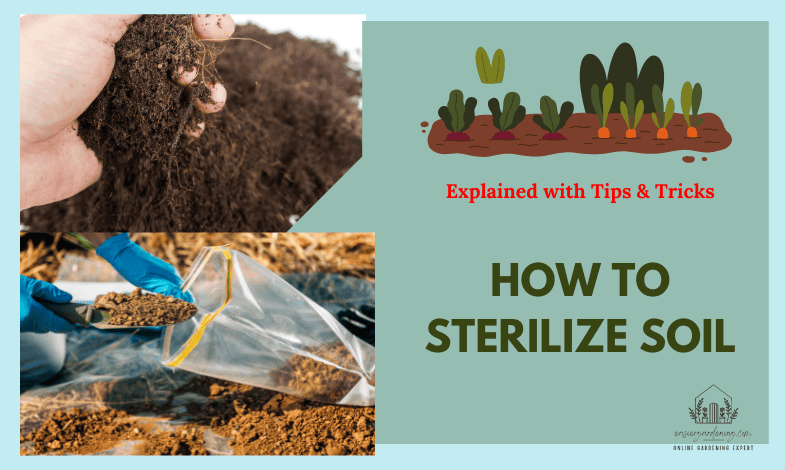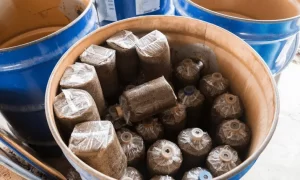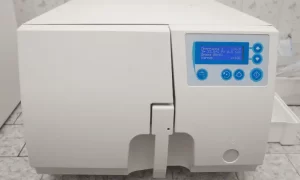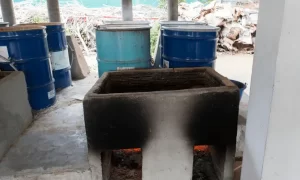Sterilize Soil: How to Make Compost Germ-free? Are you here to know how to sterilize soil? Well, you are in the right place. The soil readily makes itself available to any seed. Thus, more usually grows in the garden than we have sown. In it, even pathogens that we have long forgotten are allowed to survive. To prevent this from happening, you can sterilize the soil and make it germ-free. It is heated and unwanted life potential is nipped in the bud. It still remains fertile and allows our seeds to sprout well.
Contents
- These things are not expected
- Using temperatures hostile to life
- How do you sterilize soil: Sterilize sowing soil at home
- Microwave Oven
- Remove germs in the oven
- A larger amount of soil
- Carry out the cress test in advance
- White spots are no reason to panic
- Sterilize compost and larger amounts of soil
- Have compost steamed by a third party
- Conclusion: How to Sterilize Soil?
- What are the two main methods of soil sterilization?
- Does sterilizing soil remove nutrients?
- How do you sterilize soil at home?
These things are not expected
In soil left to itself, many things can accumulate that can harm our plants. In the worst case, destroy them. This also applies to the compost made by ourselves, which is gladly and regularly distributed in the garden as fertilizer. As well as put in the flower pots. These are for example:
- Viruses
- Fungal spores
- insect eggs
- unwanted weed seeds
Using temperatures hostile to life
All life needs an optimal ambient temperature to persist. This also applies to all life that gardeners do not want in their soil.
- There is an extended tolerance range.
- Beyond that it becomes critical.
- The simple cell structures are quickly destroyed.
- Already at temperatures around the 100 ° limit.
- Usually, 30 minutes are sufficient.
So, if you want to get rid of the pests, you have to heat the soil so much and for so long until they are destroyed. The disadvantage, however, is that the heat does not spare even the beneficial soil organisms in the compost. Therefore, the benefits must be weighed carefully.
Read more about How to measure soil moisture?
How do you sterilize soil: Sterilize sowing soil at home
How do you sterilize soil at home? The soil that benefits most from the heat is certainly the sowing soil. Or rather, it is we who benefit. Because the sterilized soil allows our seeds to emerge optimally. In it, there are no more harmful germs that can become a serious threat to the young plants. Since the sowing soil is usually needed in smaller quantities, it can be easily sterilized at home with the help of household appliances.
Microwave Oven
A lot of you may want to know how to sterilize soil in a microwave oven. It doesn’t matter whether you bought the sowing soil in a store or mixed it yourself. For a good result, you should heat both.
Tip: You can also steam a small amount of growing soil in a pressure cooker for about an hour. The hot steam will rise and make it germ-free.
Remove germs in the oven
Always heat the potting soil only immediately before use. If there are a few days between sterilization and sowing, store the cooled soil in an airtight container. In this way, no unwanted germs can get into it.
- Heat the oven to 200 °C top and bottom heat.
- Moisten the potting soil slightly.
- Spread the potting soil flat in a fireproof container.
- leave the container in the oven for 30 minutes at unchanged temperature.
- Stir larger amounts of soil in between.
- Allow the finished result to cool thoroughly before proceeding with seeding.
If the capacity of the container is not large enough, you can heat the desired amount in several passes.
A larger amount of soil
When sterilizing in the microwave, heating for ten minutes is sufficient. Set the microwave on the highest setting, which is usually 800W. Now, if you are confused about how to sterilize soil in larger amounts, don’t worry. You can sterilize larger amounts of soil in several passes, one after the other.
Carry out the cress test in advance
No soil can be seen with the naked eye how much it is “contaminated” with harmful germs, spores, seeds, and the like. On the other hand, heating larger quantities in a space-limited oven and microwave are tedious work. The cress test can clearly show us when sterilizing soil is really called for, and when it can be dispensed with.
- Fill a small pot with it
- Look cress seeds on it
Only if the cress seeds germinate within three days and then develop healthy white roots, everything is fine. Otherwise, be sure to sterilize soil in the oven or microwave.
White spots are no reason to panic
When you are here to know how to sterilize the soil, you have to be cool about something. If the soil comes black in the oven or microwave and comes out with white dots, the surprise is great. But there is a logical and comprehensible explanation for this. There were small worms or insect larvae in it, which consist mainly of protein. The protein has taken on a white color due to the effect of the heat and has thus become visible.
Tip: Soil with white spots is “harmless” and can be used without restrictions. The worms and larvae have certainly not survived the heat.
Sterilize compost and larger amounts of soil
Industrious gardeners make their own compost from plant waste. The concern that there might be undesirable germs in it, too, makes them want to heat sterilize it, just to be on the safe side. This needs to be well thought out:
- Compost is highly alive
- Full to the brim with useful microorganisms
- They continue to work after the compost fertilizer has been applied
- With their work, they improve the soil
If the decision is to sterilize, it is theoretically feasible with the equipment described above. However, the capacity of an oven quickly reaches its limits here. For the sterilization of larger quantities of soil in the private sector, special soil steamers are offered, which make it easier to sterilize larger quantities of soil.
Tip: If you do not have the opportunity to sterilize compost, you can ensure in advance that it contains as few harmful germs as possible. Dispose of weeded weeds and diseased plant parts consistently in the residual waste.
Have compost steamed by a third party
If you do not sterilize soil too often, it may not be worthwhile to purchase a soil steamer. Not only could the cost-benefit ratio be a factor, but space for its storage is also a deciding factor. Just ask a nearby large nursery if they can’t steam your compost for you. Of course, they may charge a fee for this, but it may still be worth it on the bottom line.
Conclusion: How to Sterilize Soil?
Viruses, fungal spores, insect larvae, they all lurk in garden soil and compost waiting to throw a wrench in our work. So, it is important to know how to sterilize the soil. We can defend our garden soil against them by heating the soil before use, thus rendering all unwanted germs harmless. This can also be done easily at home.
Learn more about How much water per gallon of soil?
Frequently Asked Questions
What are the two main methods of soil sterilization?
The two main methods of soil sterilization are physical control measures using steam and solar energy and Chemical control methods using herbicides and fumigants.
Does sterilizing soil remove nutrients?
No, if you can do proper sterilization. You can sterilize soil with the sun and not kill the all-important beneficial microbes
How do you sterilize soil at home?
There are several ways mentioned in this article which you can use to sterilize garden soil at home. However, for small amounts, steaming and heating the soil in the oven or microwave is the easiest and most popular option.




